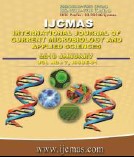


 National Academy of Agricultural Sciences (NAAS)
National Academy of Agricultural Sciences (NAAS)

|
PRINT ISSN : 2319-7692
Online ISSN : 2319-7706 Issues : 12 per year Publisher : Excellent Publishers Email : editorijcmas@gmail.com / submit@ijcmas.com Editor-in-chief: Dr.M.Prakash Index Copernicus ICV 2018: 95.39 NAAS RATING 2020: 5.38 |
Clindamycin is a substitute choice for mild to moderate Staphylococcal infections especially in penicillinâ€Âallergic patients. Staphylococcus aureus is one of the most common pathogen with ability to cause wide range of infections in humans. Clindamycin has been used to treat serious infections for more than 30 years in children. It remains effective for many infections caused by community-acquired and hospital acquired methicillin-resistant Staphylococcus aureus (CA-MRSA/ HA- MRSA). The clinical manifestations of a positive D-test begin with a perception of cross resistance among three antibiotic families that share a common binding site— Macrolides (e.g., Erythromycin) Lincosamide (e.g.; Clindamycin), and group B Streptogrammins. A positive D-test indicates the presence of MLSBi genotype, though, sub inhibitory concentration of Erythromycin is a common inducer of Inducible Clindamycin resistance (ICR). When Erythromycin diffuses on a plate streaked with Staphylococcus aureus, it induces, resistance to Clindamycin and results in flattening of the Clindamycin zone of inhibition just next to the Erythromycin disk, making a D shape, so this method is called Dâ€Âtest. Susceptibility testing was performed according to CLSI (Clinical and laboratory standard Institute) on isolates of Staphylococcus aureus by using the method of disk diffusion. Almost one third of erythromycin resistant strains have expressed inducible clindamycin resistance. MRSA isolates has higher inducible clindamycin resistance than MSSA. Henceforth D test becomes a vital part in routine laboratory procedures for the detection of inducible resistance than leading to therapeutic failure.
 |
 |
 |
 |
 |